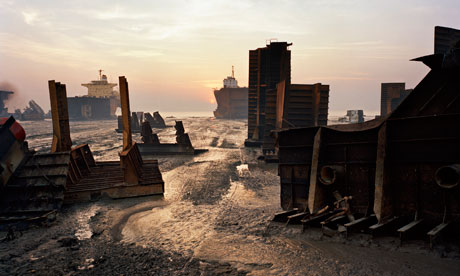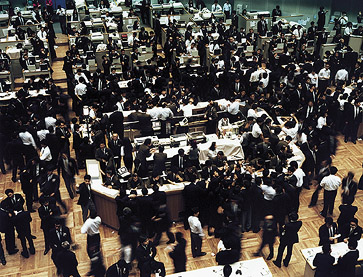Burtynsky is a well-known contemporary photographer best known for his landscapes showing manufactured senses or industrialised areas. Oil is one of Burtynskys series that contains images spanned from about 10 years.
 |
Highway #1
Los Angeles, California, USA, 2003
|
 |
Talladega Speedway #1
Birmingham, Alabama, USA, 2009
|
 |
Alberta Oil Sands #10
Fort McMurray, Alberta, Canada, 2007
|
 |
SOCAR Oil Fields #1ab
Baku, Azerbaijan, 2006
|
The series splits in three
categories which contain Extraction and Refinement, how oil is drawn from the
earth and processed for our use, Transportation and Motor Culture, the
importance and effect it has had on our lives and The End of Oil which shows the destruction and consequences oil has on nature and our
surroundings.
The thing that draws me to Burtynskys images as well as the narrative and meaning behind them, is the large scale and detail they hold. I can only imagine the effect the images create when seen up close, and the questions they make you ask about how we are relying and also taking advantage of our surroundings.
Quote by BurtynskyThe thing that draws me to Burtynskys images as well as the narrative and meaning behind them, is the large scale and detail they hold. I can only imagine the effect the images create when seen up close, and the questions they make you ask about how we are relying and also taking advantage of our surroundings.
"We are drawn by desire - a chance at good living, yet we are consciously or unconsciously aware that the world is suffering for our success."
Burtynskys
images capture the beauty and alarming scenes which society has created, they
leave us to think about how we use and see the world. The most effective
images from the series that leave the realisation of the effect we have on
nature are the ones that capture the destruction of oil to our surroundings. Shipbreaking #13, Chittagong, Bangladesh, 2000 is a perfect example of this, it captures a shipbreaking site in the soft light of the setting sun.
"This is where outdated oil tankers come to die"
Quote from http://www.theguardian.com/artanddesign/2012/may/20/edward-burtynsky-photography-oil-review
 |
| Shipbreaking #13, Chittagong, Bangladesh, 2000 by Edward Burtynsky. |
Websites visited http://www.edwardburtynsky.com/
http://thephotographersgallery.org.uk/burtynsky-oil-4
http://www.designboom.com/art/edward-burtynsky-oil-spill/
Andreas Gursky
Most recognised for his The Rhine II 1999 image that is the most expensive photograph, Gursky captures the structures and patterns of the world as it is. Like Burtynsky you're drawn to the large scale of his images. |
| Andreas Gursky. Tokyo Stock Exchange. 1990. |
Tokyo Stock Exchange, 1990 is the first stock exchange Gursky photographed and is also the first time he incorporated camera blur in to his images to give a sense of movement. Being one from a group of five stock exchange images.
Each one holds a vast amount of detail and colour and from a far look to be abstractions of colour and pattern but from close inspection you see the individual activity of each person in the images.
99 Cent is one of my favourit images from Gursky, again you're drawn to the large scale, colour, adstraction and endless amount of detail of the image. In a way Gursky is showing us something that we see everyday but makes you look at it from a different perspective.
 |
| Andreas Gursky , 99 Cent, 1999. |
http://www.tate.org.uk/art/artworks/gursky-the-rhine-ii-p78372
http://www.americansuburbx.com/2011/07/andreas-gursky-new-york-stock-exchange.html
http://www.moma.org/collection/artist.php?artist_id=7806
http://www.tate.org.uk/art/artists/andreas-gursky-2349
Lewis Baltz
 |
| Lewis Baltz West wall, Business systems division, Pertec, 1881 Langley, Costa Mesa (from The New Industrial Parks near Irvine, California), 1974 |
 |
| Lewis Baltz South wall, resources recovery systems, McGaw, Irvine, 1974 |
 |
| Lewis Baltz, The New Industrial Parks near Irvine, Element No. 5, California, 1974 |
 |
| Lewis Baltz, Fairfax, 1973 |
My idea to
capture lines, textures, patterns and space within my landscapes was influence a lot
by Baltz. His work focuses on abandoned warehouses and urban spaces, as well as
the lines, patterns and textures in his images. I particularly liked the
simplicity of his work and the contrast in each image is consistent throughout each image.
http://www.mocp.org/detail.php?type=related&kv=6860&t=people
http://alexdobson.wordpress.com/2010/09/29/photographer-lewis-baltz-new-industrial-parks-near-irvine-california/
http://www.sternberg-press.com/index.php?pageId=1302&bookId=197&l=en
Bernd and Hilla Becher
 |
| Bernd and Hilla Becher. Winding Towers, Belgium, Germany. 1971–91. |
Image from http://www.moma.org/visit/calendar/exhibitions/95
Everybody who collects something groups, whether you collect beer mugs or butterflies. ... Or stamps, for instance: you collect them for countries, colors, images, time. [Likewise] you can also group these very difficult to understand industrial buildings.--Hilla BecherQuote from http://www.getty.edu/art/gettyguide/artMakerDetails?maker=1813
Bernd and Hikka Becher who began working together in 1959 and married in 1961, are best known for their ‘typologies’- grids of precise black and white photographs of industrial sites and one of the most influential and dynamic photographic teams. The artists traveled to large mines and steel mill sites, one being the winding towers that haul coal and iron ore to the surface. They were intrigued by the fact that so many of these industrial buildings seemed to have been built with a great deal of attention toward design. The images were then displayed side by side to invite viewers to compare their forms and designs. The images portray simplisity yet hold a vast amount of detail.
http://www.moma.org/visit/calendar/exhibitions/95
http://www.moma.org/explore/inside_out/2010/07/29/recent-acquisition-bernd-and-hilla-bechers-winding-towers
http://www.moma.org/collection/artist.php?artist_id=8095
http://poulwebb.blogspot.co.uk/2011/01/bernd-and-hilla-becher-photography.html
No comments:
Post a Comment